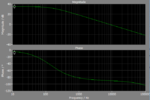- Joined
- Jan 22, 2008
- Messages
- 52,335
- Helped
- 14,741
- Reputation
- 29,764
- Reaction score
- 14,080
- Trophy points
- 1,393
- Location
- Bochum, Germany
- Activity points
- 297,703
Re: what are the best software to simulate a boost converter with current control ?
I fail to recognize how the said "vout/verr" transfer function is different from the loop gain already derived at the start of this thread, but evaluated for a different loop, the outer voltage control.
A possible trap door in case of the discussed converter is that the loop gain partly varies with the operation point, particularly in DCM. Thus it's suggested to operate the system in feedback with a useful set point.
I fail to recognize how the said "vout/verr" transfer function is different from the loop gain already derived at the start of this thread, but evaluated for a different loop, the outer voltage control.
A possible trap door in case of the discussed converter is that the loop gain partly varies with the operation point, particularly in DCM. Thus it's suggested to operate the system in feedback with a useful set point.





